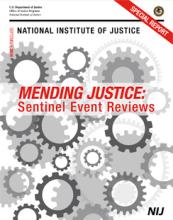Law enforcement
Infusing Community Policing Strategies into Hot Spots Policing Practices: The Impacts on Police-Community Relations in a Mid-Sized City
2017-R2-CX-0012
Past Project Period End Date
Funding First Awarded
2019
$737,561
Campus Sexual Assault Responses (CSAR): Informing Trauma-Informed Policies, Protocols, and Training
2019-VA-CX-K001
Closed
Funding First Awarded
2019
$999,999
Law Enforcement Vehicle Lighting and Reflectivity Studies: An Overview
Date Published
2019
Agencies
NIJ-Sponsored
Publication Type
Research (Applied/Empirical),
Instructional Material,
Historical Overview
Notes from the Field: Leveraging Broadband Communications to Improve Public Safety
Date Published
September 2019
Agencies
NIJ
Publication Type
Issue Overview
Developing, Implementing, and Evaluating a Police Fatigue Risk-Management Strategy for the Seattle Police Department
2019-R2-CX-0022
Closed
Funding First Awarded
2019
$668,696
Atypical Work Hours and Adaptation in Law Enforcement: Targets for Disease Prevention
2019-R2-CX-0021
Closed
Funding First Awarded
2019
$834,177
Expanding Mental Health Diversion Opportunities: A Prospective Evaluation of the Los Angeles County Intake Booking Diversion Program
2019-R2-CX-0033
Closed
Funding First Awarded
2019
$1,000,000
Mass Marketing Elder Fraud Intervention
2019-R2-CX-0053
Open
Funding First Awarded
2019
$988,159
ASEBP Program in Applied Criminology and Crime Management
2019-75-CX-0007
Past Project Period End Date
Funding First Awarded
2019
$500,000
Cybersecurity and Safety Challenges in Autonomous Vehicles: Threats Identification and Countermeasures Development
2017-R2-CX-0001
Closed
Funding First Awarded
2019
$47,131
Improving the Forensic Documentation of Injuries through Alternate Light: A Researcher-Practitioner Partnership
2019-NE-BX-0008
Closed
Funding First Awarded
2019
$398,719
Understanding the Effects of Fatigue on Law Enforcement
Date Published
May 2017
Agencies
NIJ
Publication Type
Research (Applied/Empirical),
Report (Grant Sponsored),
Interview
Application for Funding to Support the National Missing and Unidentified Persons System (NamUs)
2016-MU-BX-K007
Past Project Period End Date
Funding First Awarded
2019
$5,500,000
Criminal Justice Requirements and Resources Consortium
2018-75-CX-K006
Past Project Period End Date
Funding First Awarded
2019
$1,500,000
Criminal Justice Testing and Evaluation Consortium
2018-75-CX-K003
Past Project Period End Date
Funding First Awarded
2019
$3,500,000
Funding to support the operation of the Secretariat of ISO/IEC JTC 1/SC 37, Biometrics
2016-IJ-CX-0112
Closed
Funding First Awarded
2019
$46,100
Criminal Justice Requirements Resources Consortium
2018-75-CX-K007
Open
Funding First Awarded
2019
$300,000
Sharing Ideas and Resources To Keep Our Nation's Schools Safe! (Volume VI)
Date Published
June 2018
Agencies
NIJ-Sponsored
Publication Type
Report (Study/Research),
Report (Grant Sponsored),
Program/Project Description,
Instructional Material
Mending Justice - Sentinel Events in Criminal Justice
Date Published
September 2014
Agencies
NIJ
Publication Type
Issue Overview
Developing, Visualization, and Reporting a Combined 2D+3D Automated Dental Biometrics Identification System for Forensic Odontology
2019-R2-CX-0036
Closed
Funding First Awarded
2019
$100,000
Crime and Victimization on the US-Mexico Border: A Comparison of Legal Residents, Illegal Residents and Native-Born Citizens
2019-R2-CX-0054
Closed
Funding First Awarded
2019
$521,702
Through the Looking Glass Part II: Abuse of the Evolving Electronic Cigarette and the Impact of Vaping Ethanol in the Evaluation of Impairment
2019-MU-MU-0007
Past Project Period End Date
Funding First Awarded
2019
$1,241,355
Novel GLC-based Method for Identification of Positional Isomeric Fentanyls
2019-R2-CX-0043
Closed
Funding First Awarded
2019
$50,000



